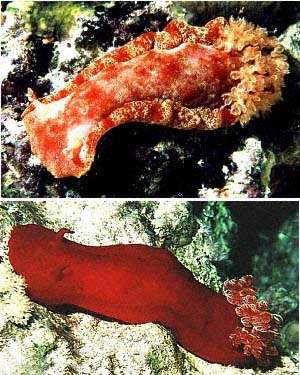
Hexabranchus sanguineus
(Ruppell & Leuckart, 1828)
Order: NUDIBRANCHIA
Suborder: DORIDINA
Family: Hexabranchidae
DISTRIBUTION
Tropical Indo-West Pacific
PHOTO
UPPER RIGHT: Colour forms from Philippines (upper) and Red Sea (lower). PHOTOS: Erwin Koehler.
BELOW: Yellow colour form, right photo showing start of swimming sequence. Fungu Yasin, Dar es Salaam, Tanzania, February 1979. PHOTOS: Bill Rudman.
The species was first described from the Red Sea and based on a red colour form. The mottled form (Philippines photo) is the most common colour form, although yellow animals have been reported from Hawaii and here from Tanzania. Thanks to Erwin Koehler for the upper two photos. Apart from being able to swim, Hexabranchus is an unusual member of the Superfamily Eudoridoidea in that its gills do not have a gill pouch into which the gills can retract. Also each gill is inserted separately into the body wall. Hexabranchus sanguineus is one of the largest of all nudibranchs with animals being recorded at over 40cm in length. See Wayne Ellis' photo of an animal swimming.
See References on biology and natural history.
See Hexabranchus sanguineus Page 2.
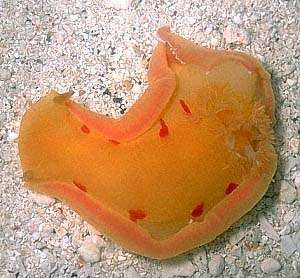
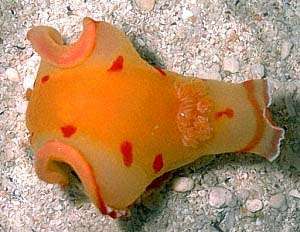
Rudman, W.B., 1999 (March 31) Hexabranchus sanguineus (Ruppell & Leuckart, 1828). [In] Sea Slug Forum. Australian Museum, Sydney. Available from http://www.seaslugforum.net/find/hexasang
Related messages
Hexabranchus sanguineus from Pemba
November 20, 2002
From: Paul Young
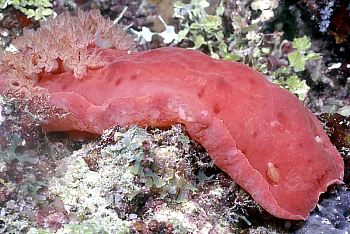
Dear Bill,
Here is another nudibranch that Charlotte and I found at Pemba Island, off the coast of Tanzania, western Indian Ocean, in November/December 2001. This one was seen on 1 December. It was from the west coast of Pemba where we dived with the Fundu Lagoon Resort to small nearby islands. Night dive
Best wishes,
Paul Young
young@underwater.org
Young, P., 2002 (Nov 20) Hexabranchus sanguineus from Pemba. [Message in] Sea Slug Forum. Australian Museum, Sydney. Available from http://www.seaslugforum.net/find/8417Dear Paul,
This is a rather shy looking Hexabranchus sanguineus. In fact the Spanish Dancer is only a spectacular 'dancer' when it trying to escape from danger. Normally it sits like this, looking quite camouflaged and nonedescript. It is only when it unfolds the sides of its mantle to show the bright red and white colour pattern is it instantly recognisable. See the Colour in Sea Slugs page for further information.
Best wishes,
Bill Rudman
Spanish Dancer? from the Maldives
July 29, 2001
From: Paula Zylstra
Hi Bill
I have a question but unfortunately no photo - always seem to leave the camera behind when we need it! We did a night dive in the Maldives on 13 July 2001 where we found a ~25-30 cm nudibranch. It was a uniform dark red, smooth body, in about 3-4m of water.
We thought it was a Spanish Dancer, but it appeared to have a single cluster of gills, not the 6 separate ones I've read about (when we first shone the torch on it it retracted the gills and I'm sure there weren't 6 separate bunches). The dive guide said Spanish Dancers were rare in the Maldives.
Does this sound like anything you know?
Thanks for your help
Paula
paula.zylstra@health.gov.au
Zylstra, P., 2001 (Jul 29) Spanish Dancer? from the Maldives. [Message in] Sea Slug Forum. Australian Museum, Sydney. Available from http://www.seaslugforum.net/find/4921Dear Paula,
An animal that large, and red, is most probably a Spanish Dancer [Hexabranchus sanguineus]. If you look through the messages on the Hexabranchus page you will see quite few photos of different colour forms. Concerning the gills. In most dorid nudibranchs with a relatively flattened body [eg Discodoris, Platydoris, Jorunna etc] the gills all contract into a single gill pocket. In Hexabranchus there is no gill pocket and each gill is inserted independently into the body wall. However when the gills are all extended it is hard to see the basal region and until they are maximally retracted it is difficult to see that they are independent of each other.
For future reference, one sure way of identifying Hexabranchus is to have a look at its mouth. Instead of having a single oral tentacle on each side, it has flap of tissue with a number of finger-like projections. Another fairly convincing test is to see if it will swim with the characteristic dorso-ventral muscle waves along the body.
Off-hand I can't think of any other uniformly dark red nudibranch of that size. Without some more clues I can't really help. Did anyone touch it? was it soft and fleshy or hard and rough? etc etc.
Best wishes,
Bill Rudman
Juvenile Hexabranchus from Pearl Harbour
July 28, 2001
From: Anuschka
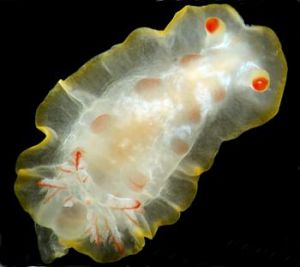
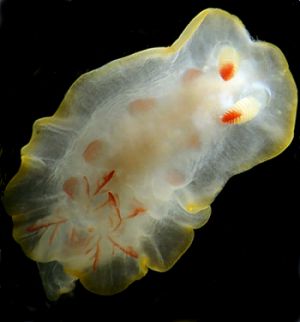
Dear Bill
Here is a nudibranch I couldn't identify. I think it is a Chromodoris, but I am not sure. We found it (14mm long) on a sponge at Pearl Harbor, Honolulu, Hawaiian Ids, at 1m depth on the 23 July 2001.
Could you identify this animal?
Anuschka
anuschkaf@hotmail.com
Anuschka, 2001 (Jul 28) Juvenile Hexabranchus from Pearl Harbour. [Message in] Sea Slug Forum. Australian Museum, Sydney. Available from http://www.seaslugforum.net/find/4949
Dear Anuschka,
This certainly looks like a chromodorid but although I have not seen this colour form before I am pretty sure it is a juvenile Hexabranchus sanguineus - the Spanish Dancer. In adults one character of Hexabranchus is that each gill is separately inserted into the skin of the body wall. This is not so easy to see in live juveniles, although it is usually clear when they are dead and preserved. One clear external difference from most chromodorids is that the gills are branched, which you can see in your photo.
If you look through other messages on this page you will see the red patches on the back are quite consistent in many colour forms. However the yellow border in your animal is an unusual variation. One other feature found only in Hexabranchus is the shape of the oral tentacles on either side of the mouth. Instead of being a single tentacle or flap of tissue, each 'tentacle' is a handlike flap with a series of fingers. I will try and find a photo and post it on the Forum. Unfortunately it is not a feature you can see in photographs of the dorsal surface.
Best wishes,
Bill Rudman
Hexabranchus sanguineus and purple ink?
July 7, 2001
From: Friedrich Huneke
Hi!
When I was looking for a photo of a "Purple producing snail", murex etc, I was offered photos of a Hexabranchus sanguineus, but I think they do not produce the red purpur colour used anciently for expensive, royal dress. May you help me?
Thanks
Friedrich Huneke
huneke@schroedel.de
Huneke, F., 2001 (Jul 7) Hexabranchus sanguineus and purple ink?. [Message in] Sea Slug Forum. Australian Museum, Sydney. Available from http://www.seaslugforum.net/find/4750Dear Friedrich,
Hexabranchus certainly doesn't produce the royal purple dye. I have discussed the origin of this 'Tyrian Purple' in a couple of messages [message 1, message 2]. Have a look at them for some background information. Sea Hares also produce a purple ink but it is not used in producing dyes.
Best wishes,
Bill Rudman
Spanish Dancer from northwestern Australia
April 19, 2001
From: Drew Taylor
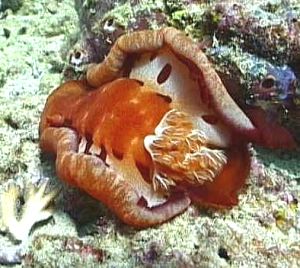
Dear Bill,
I have attached some photos of a Spanish Dancer that were taken in Lighthouse Bay, Exmouth (North West Australia) by a friend of mine named Paul Waghorn on 14 April 2001.
The subject was 15cm long and in 14 metres of water.
Can you please identify it for me?
Regards
Drew Taylor
orcaunderwater@nwc.net.au
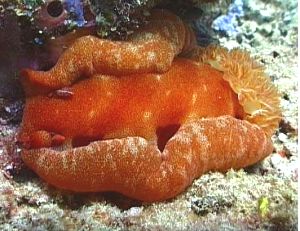
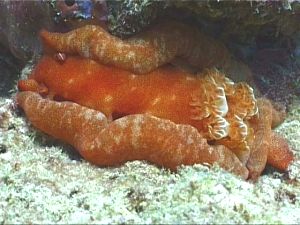
Dear Drew,
The scientific name of the Spanish Dancer is Hexabranchus sanguineus. If you look at the other messages on this page you will see it has quite a colour range and can grow to a very large size.
Best wishes,
Bill Rudman
Red Sea Spanish Dancers
March 1, 2001
From: Jochen Scholtyssek
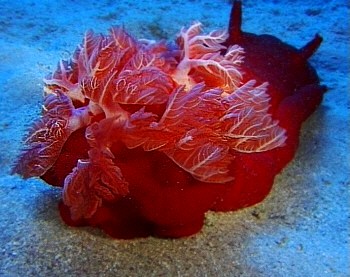
Dear Bill,
These pictures are from a digital videotape that I took in the Red Sea in Akaba, Jordan in 25 meters of depth. They show the Spanish Dancer [Hexabranchus sanguineus] swimming. The animal is 40cm long.
The dive site id the Royal Diving Center, December 2000.
Best wishes
Jochen Scholtyssek
joscholty@t-online.de
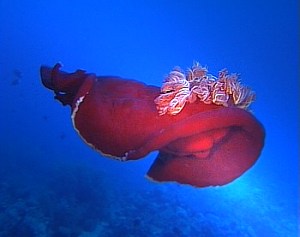
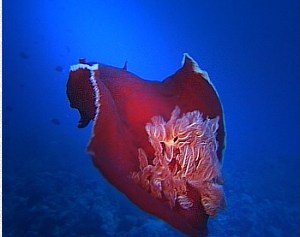
Dear Jochen,
Thanks very much for the photos. The Red Sea Hexabranchus is definitely very red. Has anyone any photos of a Red Sea Hexabranchus that is not this uniform red colour?
Best wishes,
Bill Rudman.
Hexabranchus sanguineus from Red Sea
February 10, 2001
From: David Harasti
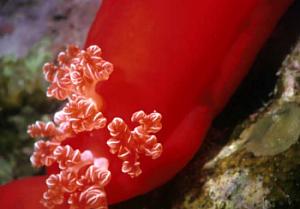
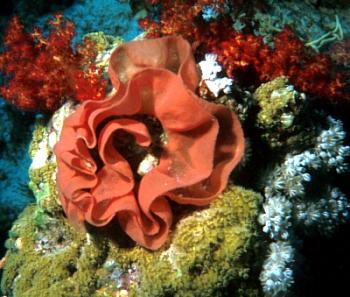
Hi Bill,
Here is a close up of Hexabranchus sanguineus from the Red Sea and also a picture of it's eggs.
Cheers,
David
www2.dynamite.com.au/davidh
davidh@dynamite.com.au
Harasti, D., 2001 (Feb 10) Hexabranchus sanguineus from Red Sea. [Message in] Sea Slug Forum. Australian Museum, Sydney. Available from http://www.seaslugforum.net/find/3754Thanks David,
This animal was first described from an animal collected in the Red Sea. The name 'sanguineus' means 'bloody' or 'blood red', which is very appropriate for this deep uniform red colour form found in the Red Sea.
Bill Rudman.
'Spanish Dancer' dancing
February 10, 2001
From: David Harasti
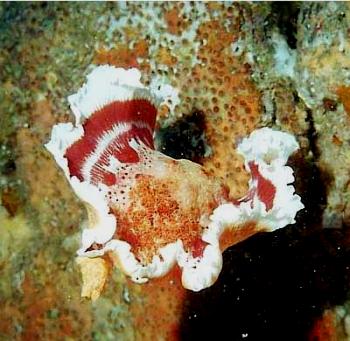
Hi Bill,
Here is a 'dancing' picture of Hexabranchus sanguineus. It was taken at North Solitary Island [Coffs Harbour, nthn New South Wales, Australia] in January 2001.
Cheers,
David
www2.dynamite.com.au/davidh
davidh@dynamite.com.au
Harasti, D., 2001 (Feb 10) 'Spanish Dancer' dancing. [Message in] Sea Slug Forum. Australian Museum, Sydney. Available from http://www.seaslugforum.net/find/3756Thanks Dave,
They are really spectacular when they are 'dancing / swimming'.
Bill Rudman
Hexabranchus from the Solitary Islands.
February 9, 2001
From: David Harasti
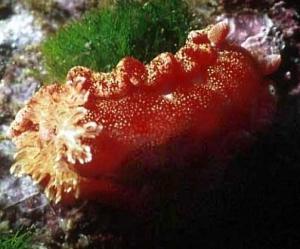
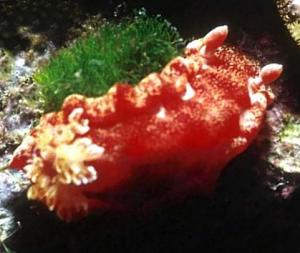
Hi Bill,
Here is another species from the Solitary Islands [off Coffs Harbour, nthn New South Wales, Australia] that I am unsure of. It was about 3-4 cms long, found in 10 metres of water at North Solitary Island near Elbow Cave.
I thought it could be a juvenile Spanish Dancer? Hope you can help me identify it.
Thanks,
David
davidh@dynamite.com.au
Harasti, D., 2001 (Feb 9) Hexabranchus from the Solitary Islands.. [Message in] Sea Slug Forum. Australian Museum, Sydney. Available from http://www.seaslugforum.net/find/3721Dear David,
Yes it is a small Hexabranchus sanguineus. When they are very juvenile they look very like a species of chromodorid. Have a look at Mike Miller's photo in an earlier message
Bill Rudman
Spanish Dancer
October 28, 2000
From: Alicia Buckley
Our year 5 class in Melbourne, Australia would like some information about Spanish Dancers please. We think they are very beautiful.
Thank you from
Alicia
mbuckley@vtown.com.au
Buckley, A., 2000 (Oct 28) Spanish Dancer. [Message in] Sea Slug Forum. Australian Museum, Sydney. Available from http://www.seaslugforum.net/find/3252Dear Alicia,
The Spanish Dancer's scientific name is Hexabranchus sanguineus. In the Forum each species has its own page, and messages about a species are all on that page. So I have put your message on the Hexabranchus Page.
If you look above your message you will find some photos and general information on the Spanish Dancer and if you look below your message your will other messages about it. Many of these messages have nice photos of animals from different parts of the pacific and Indian Oceans. If you look at all htat information I think you will find all the information you will need.
One thing I don't think you'll find is why its name is Hexabranchus sanguineus. Hexabranchus = six gills and sanguineus = blood and refers to its red colour.
I am not sure how much you know about using websites. One useful thing to know is that if you click on any word or group of words that are coloured and underlined, you will go to a new page which is about the word you clicked on.
Best wishes,
Bill Rudman.
Hexabranchus sanguineus size
September 22, 2000
From: Marli Wakeling
Hello again,
Last year off of Flores, Indonesia, I mentioned to all on board that I was "into" nudibranchs, and was disappointed I hadn't seen many. The dive guide came up to me on the next dive, with his fin in hand. He then placed it beside two Spanish Dancers that were longer! As I have the same fins, I measured them at over 24" in length.
Marli Wakeling
scubamarli@excite.com
Wakeling, M., 2000 (Sep 22) Hexabranchus sanguineus size. [Message in] Sea Slug Forum. Australian Museum, Sydney. Available from http://www.seaslugforum.net/find/3052Thanks Marli,
At a rough conversion that is about 60cms. Definitely beats the 52cm I mentioned before.
As Sydney is the home of the Olympics as well as the Sea Slug Forum, can I mention that in the Olympic Games opening ceremony they had an underwater world sequence, and apart from the usual fish and jellyfish I was pleased to see a swimming Hexabranchus! Not what I would call a gold medal swim but as the commentator's are saying as their favourite misses out on a medal, it was a "a creditable performance".
Best wishes,
Bill Rudman.
Re: Hexabranchus mating
September 11, 2000
From: Erwin Koehler
Dear Leticia,
Concerning your question about Hexabranchus mating. There are fantastic photos of very large animals mating and laying eggs
at Mike Miller's Slug Site at: http://siolibrary.ucsd.edu/slugsite/mulliner/nudwk125.htm
Erwin
Medslugs.Koehler@t-online.de
Koehler, E., 2000 (Sep 11) Re: Hexabranchus mating. [Message in] Sea Slug Forum. Australian Museum, Sydney. Available from http://www.seaslugforum.net/find/3009How do Spanish Dancers reproduce?
September 7, 2000
From: Leticia I.
To whom it may cooncern,
Hello my name is Leticia from Hawaii. Our class is doing research on invertebrates and vertebrates. Each group had to pick one of each. My group chose a Hawaiian Monk Seal for our vertebrate and for an invertebrate we choose a Spanish Dancer (Hexabranchus sanguineus). I found info about it's habitat and diet but for some reason I can't find info on how it reproduces.
Can you help me?
Leticia
Party_gurl_808@goppplay.com
Leticia I., 2000 (Sep 7) How do Spanish Dancers reproduce?. [Message in] Sea Slug Forum. Australian Museum, Sydney. Available from http://www.seaslugforum.net/find/2976Dear Leticia,
You certainly chose a spectacular invertebrate to study. Have a look at all the messages and photos of Hexabranchus above and below your message. You will find quite a lot of information there. If you are able to visit a library that has the scientific journal The Veliger there is a very good article which has all the information you would need:
• Francis, M.P. (1980) Habitat, food and reproductive activity of the nudibranch Hexabranchus sanguineus on Tongatapu Island. The Veliger, 22(3): 252-258.
Perhaps your teacher or one of your parents could help you find it, as The Veliger is an American scientific journal which most museums and university libraries should have.
Basically all sea slugs are hermaphrodite. That is they have a full set of male and female organs. They don't fertilise their own eggs however, but every time they mate they are able to give and receive sperm, so doubling their opportunity to pass on their genes. They lay a large frilly pink egg mass with thousands of tiny eggs which hatch out as free-swimming veliger larvae, which swim for some time in the plankton before settling down and turning into tiny crawling slugs. Use the SEARCH button to find information on veligers [type veliger]. You will also find a photo below of a very small Hexabranchus which looks quite different from the adults, and is unable to swim.
I hope this will help you with your project. Have a look at some of the General Topic pages for some more information on nudibranchs.
Good Luck with your project,
Best wishes,
Bill Rudman.
The world's biggest nudibranch
September 5, 2000
From: Bruce Wight
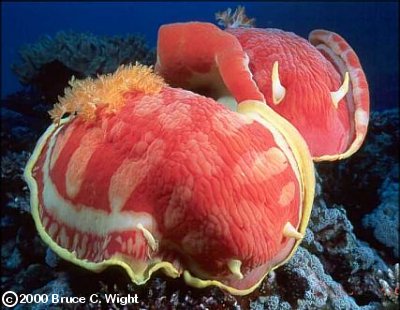
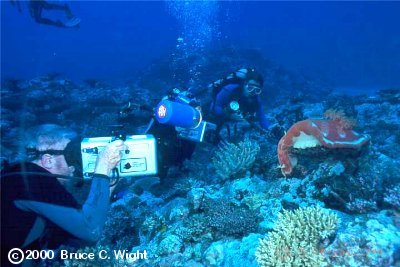
Hi Bill,
I know you want the pictures of the Melibe, but I had to send you these photos I just took off the Island of Beqa in Fiji last week. These were the biggest branchs I have ever seen. I have seen some large Aplysia vaccaria diving around here in our local waters of Southern California, but these branchs made the Aplysia look small. I think they are a large form of the species Hexabranchus sanguineus . I have seen Hexabranchus in other tropical Pacific areas before, but they are usually 6 to 8 inches long. These two were 18 or more inches long and 12 inches across. I included a photo of them with some divers so you could get a sense of scale. Have you ever seen any this large? These two were found on the sand at 130 feet, but after we got out of the water I talked with one of the dive guides and he told me that he has seen even larger ones in the shallower water around 30 feet. This was the first time I have ever used a wide angle 24mm lens to photograph nudibranchs instead of some type of macro lens. Look close and you can clearly see a Periclimenes shrimp on one of them. Will get those shots of the Melibe to you sometime over the weekend.
Take care
Bruce Wight
bwproductions@earthlink.net
Wight, B., 2000 (Sep 5) The world's biggest nudibranch. [Message in] Sea Slug Forum. Australian Museum, Sydney. Available from http://www.seaslugforum.net/find/2965Dear Bruce,
Firstly thanks again for the beautiful shots of Melibe leonina.
Concerning your large nudibranchs. Although I don't think there has been any anatomical study undertaken, the prevailing view is that they are very very large Hexabranchus sanguineus. I have previously mentioned on the Largest, heaviest, etc page of reports of Hexabranchus growing to at least 520mm in length off Djibouti in the Red Sea (Double, 1992). I have also seen photos of very similarly sized animals from deepwater off Fiji. Interestingly these large animals all seem to have a very similar colour pattern. On a rough conversion your 18 inches equals about 45cm, so your animals are definitely of similar size to those from the Red Sea give or take a bit of stretching.
Thanks for these great shots Bruce. I had been thinking that since in 2 weeks time Sydney is going to be swamped by the Olympic Games this would be a good time to make a call for some messages about the biggest, shortest, longest etc sea slug. If anyone has any candidates I'll of course need some photographic evidence so no fishermen's tales please.
Best wishes,
Bill Rudman.
Reference: Double, T. (1992) Here be Giants. BBC Wildlife, 10(5): 34-40.
Rudman, W.B., 2000 (Sep 5). Comment on The world's biggest nudibranch by Bruce Wight. [Message in] Sea Slug Forum. Australian Museum, Sydney. Available from http://www.seaslugforum.net/find/29654-gilled Hexabranchus
September 4, 2000
From: Erwin Koehler
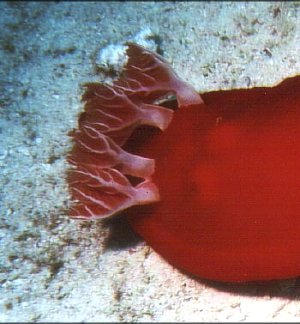
Dear Bill,
Here is a close-up of a Hexabranchus sanguineus with 4 gills only.
The photo was made by Britta Hochberger.
Email Ott.Hochberger@t-online.de
in the Gulf of Aqabah (Red-Sea, Egypt) in July 2000 during a nightdive.
Size and depth were not recorded.
Erwin
Medslugs.Koehler@t-online.de
Koehler, E., 2000 (Sep 4) 4-gilled Hexabranchus. [Message in] Sea Slug Forum. Australian Museum, Sydney. Available from http://www.seaslugforum.net/find/2964Thanks Erwin & Britta,
Bill Rudman.
Juvenile Hexabranchus sanguineus
August 18, 2000
From: Valda Fraser
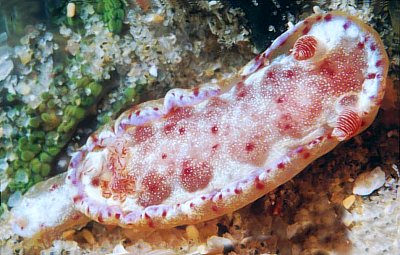
Dear Bill
This nudibranch swims like Hexabranchus sanguineus. What is it? Please help?
Locality: Sodwana, north coast KwaZulu/Natal - 10m SOUTH AFRICA
Date: August 2000
Size: 20mm
Regards
Valda Fraser
iti04937@mweb.co.za
Fraser, V., 2000 (Aug 18) Juvenile Hexabranchus sanguineus. [Message in] Sea Slug Forum. Australian Museum, Sydney. Available from http://www.seaslugforum.net/find/2890Dear Valda,
It is a juvenile Hexabranchus sanguineus. I'm glad you mentioned it swimming, as I have often wondered at what size it began swimming. Have a look at Mike Miller's message and photo of an even smaller one.
You are not the first to be fooled by these juveniles. I was pretty sure it was a chromodorid some years ao when I was reviewing Chromodoris decora and similarly coloured species. The separated gills seemed a bit strange but it wasn't until I looked at the radula and couldn't find a reproductive system that I realised what it was.
Best wishes,
Bill Rudman.
Re: Okinawan Hexabranchus Color variant
July 1, 2000
From: Bob Bolland
Hi Bill,
Re the recent Okinawan Hexabranchus color variant, this is the only one I've seen here having this color phase.
Cheers,
Bob
bollandr@rapid-link.ne.jp
Bolland, R.F., 2000 (Jul 1) Re: Okinawan Hexabranchus Color variant. [Message in] Sea Slug Forum. Australian Museum, Sydney. Available from http://www.seaslugforum.net/find/2640Hexabranchus color variation from Okinawa
June 30, 2000
From: Bob Bolland
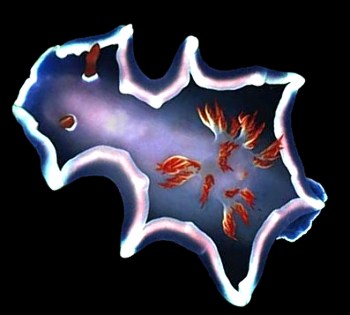
Hi Bill,
Here's an interesting color variation of Hexabranchus to go along with with those already posted on the Forum. Also, it would appear to "almost have" a seventh gill cluster.
Data: RFB #3468-A / TL: 77mm / 56m / Seragaki, Okinawa / 20 Aug 1995
Cheers,
Bob
bollandr@rapid-link.ne.jp
Bolland, R.F., 2000 (Jun 30) Hexabranchus color variation from Okinawa. [Message in] Sea Slug Forum. Australian Museum, Sydney. Available from http://www.seaslugforum.net/find/2634Thanks Bob,
First time I have seen a blue one. Is it unique or uncommon or do you find it often?
Cheers,
Bill Rudman.
Spanish Dancer - Hexabranchus sanguineus
May 18, 2000
From: Brandon
I am doing a report on the nudibranch (specifically the Spanish Dancer) and the only information I cannot find is at what age do they reach sexual maturity. I know their life span is not long, but I have not been able to find how "old" they are when they can reproduce. Is that information available?
Brandon.
dcjones@manatawny.org
Brandon, 2000 (May 18) Spanish Dancer - Hexabranchus sanguineus. [Message in] Sea Slug Forum. Australian Museum, Sydney. Available from http://www.seaslugforum.net/find/2400Dear Brandon,
There was a paper some years ago by by Francis (1980) on aspects of the life history of Hexabranchus. I am not 100% certain, but I think he had some information on how old they were when they began egg laying.
It is in in The Veliger. I'm afraid I am working from home for a few days and don't have the paper available. Have a look at the page of references on Hexabranchus biology for a citation.
Best wishes,
Bill Rudman.
Keeping a Spanish Dancer alive
May 6, 2000
From: Roy
How can I keep my Spanish Dancer alive and what can I feed it?
thank you,
Roy.
memiroc@aol.com
Roy, 2000 (May 6) Keeping a Spanish Dancer alive. [Message in] Sea Slug Forum. Australian Museum, Sydney. Available from http://www.seaslugforum.net/find/2198Dear Roy,
The Spanish Dancer, Hexabranchus sanguineus, grows to quite a large size, and like most dorid nudibranchs, it feeds on only a few species of sponge. To keep it alive successfully you would need to identify its natural sponge food, or find an alternative that it would eat. You would then need to have an easily available continuous supply of the sponge for food.
Have a look at the information on Hexabranchus above your message on this page, and at the earlier messages and discussion on Hexabranchus which are below your message on this page. You will also find a link to a page of references on its biology and natural history.
Best wishes,
Bill Rudman.
Pink Spanish Dancer
March 18, 2000
From: Mary Jane Adams
Dear Bill,
I did not give a size estimate for the pink Spanish dancer in my last photo because it has been several years since I saw it. Sorry! I do recall that it was not particularly large, perhaps about 25 cm long.
Thanks,
Mary Jane
mjadams@earthlink.net
Adams, M.J., 2000 (Mar 18) Pink Spanish Dancer. [Message in] Sea Slug Forum. Australian Museum, Sydney. Available from http://www.seaslugforum.net/find/2110Thanks Mary Jane,
Bill.
Pink Spanish Dancer
March 17, 2000
From: Mary Jane Adams
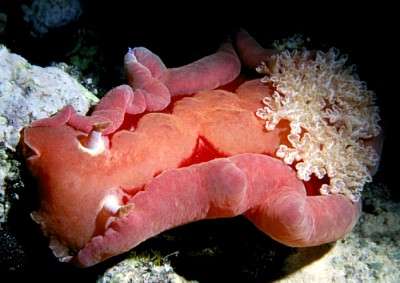
Dear Bill,
I found this Hexabranchus sanguineus on a night dive near New Ireland Island, Papua New Guinea. It seems to be a rather unusual color. Depth about 8 meters, rubble patch on a coral reef. Sept. 30, 1993.
Best regards,
Mary Jane Adams
mjadams@earthlink.net
Adams, M.J., 2000 (Mar 17) Pink Spanish Dancer. [Message in] Sea Slug Forum. Australian Museum, Sydney. Available from http://www.seaslugforum.net/find/2095Dear Mary Jane,
Was this a big animal? Some of the larger specimens, especially from deeper sites are often a more uniform pink colour like this.
Best wishes,
Bill Rudman.
Hexabranchus sanguineus Video
March 1, 2000
From: Marco Peters
Hi there,
A simple question:
Do you know of a site where I can find a video/mpeg file of a Hexabranchus sanguineus while 'dancing'?
Marco Peters
marcopeters@hotmail.com
Peters, M., 2000 (Mar 1) Hexabranchus sanguineus Video. [Message in] Sea Slug Forum. Australian Museum, Sydney. Available from http://www.seaslugforum.net/find/1985Dear Marco,
I'm afraid not. Perhaps someone reading this will let us know if they have seen one.
Best wishes,
Bill Rudman.
Hexabranchus sanguineus
November 20, 1999
From: Danielle Manacop
Hello my name is Danielle,
I would like to know more about the Hexabranchus sanguineus. I have a report due in 2 weeks and I am having trouble finding information. If you could please help me by telling me of what you know, and if you know of sites about them then please could you e-mail them to me. I need to know all about them, like their sexual reproduction, eating habits, interior organs, and things like that. I live on Saipan and our library does not contain much information on these organisms. If you could please help. Please e-mail me.
Thank you
Danielle Manacop
dmanacop@hotmail.com
Manacop, D., 1999 (Nov 20) Hexabranchus sanguineus. [Message in] Sea Slug Forum. Australian Museum, Sydney. Available from http://www.seaslugforum.net/find/1551Dear Danielle,
I guess the Saipan your are talking of is in the Northern Mariana Islands north of Guam. Sounds a great place to find nudibranchs.
I have prepared a list of references on Hexabranchus sanguineus for you. Hopefully you will be able to obtain a few of these. The one by Francis in The Veliger is quite comprehensive.
In brief, Hexabranchus can be found in tropical waters worldwide from the intertidal to quite deep water - deeper than scuba divers can safely venture. It is a sponge-feeder but does not seem to be a specialised feeder on a particular species of sponge. The skeletal spicules of many encrusting sponges have been found in its stomach. Hexabranchus seems to breed all year, though in the Red Sea it is reported to stop breeding during the coldest period of the year. The bright red egg ribbons are quite characteristic.
Like many nudibranchs, Hexabranchus seems to be protected somehow from fish predation. The bright red colour on their mantle has long been considered a 'warning' colouration to fish. In the last ten years or so we now have evidence to show that Hexabranchus has distasteful, and potentially toxic, chemicals in its body and egg masses. These chemical molecules (macrolides) are almost identical to antifeedant chemicals found in Halichondria, one of the sponges that Hexabranchus eats. The sponge produces the molecules to protect it from fish predation. It is thought that Hexabranchus obtains the molecules from the sponge during feeding, and after modifying the structure of the molecule slightly, stores them in its skin and egg masses for its own protection.
I hope this will help you with your project. You will also find more information in the other messages about Hexabranchus below yours on this page. Also have a look at the Index of general topics for more information on other aspects of dorid and nudibranch biology.
Best wishes,
Bill Rudman.
'Spanish Dancer'?
July 14, 1999
From: Emily Stitt
I was vacationing down on South Padre Island, and we saw this animal that looked like a jelly fish ? but when further examination we saw it was not one?? some man said it was a Spanish dancer otherwise known as a sea slug. I was just wondering if you could send a picture and info so my kids can see what it looks like.
Thanks so much,
Emily Stitt
ssjms@msn.com
Dear Emily,
Where in the world is South Padre Island? Although the internet brings us all closer together it is still a very big planet. As each region has its own unique nudibranchs, I could give you a better answer if I knew which part of the world we're talking about. Have a look at the page on the Spanish Dancer. There is some information at the top of the page and if you move down through the messages you will find a spectacular photo from Wayne Ellis of it swimming. It gets it name 'Spanish Dancer' from the resemblance of its red and white edged 'ruffled' mantle, to the dress of a Spanish Flamenco Dancer.
However the Spanish Dancer is found in the tropical Indian and West Pacific Oceans. If South Padre Island is in California, or your animals didn't look like the photos here, perhaps you should let me know and I'll try again. Perhaps you could tell me a little about its shape and colour.
Best wishes,
Bill Rudman.
Hexabranchus sanguineus from South Africa
July 12, 1999
From: Ernest C.J. Seamark
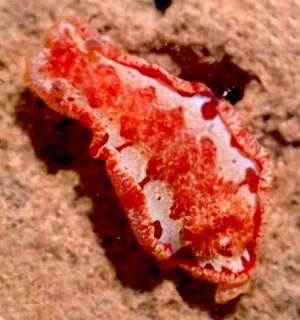
This species has been found iregularly throughout the year at Treasure Beach, Durban, KwaZulu Natal, South Africa in the intertidal zone. It has been feeding on an yellow/brown sponge.
Ernest Seamark
kearneyt@biology.und.ac.za
Seamark, E.C.J., 1999 (Jul 12) Hexabranchus sanguineus from South Africa. [Message in] Sea Slug Forum. Australian Museum, Sydney. Available from http://www.seaslugforum.net/find/1041Dear Ernest,
Thanks for this and the other photos you have sent. I will be posting them on the site when I organise answers. From one of your earlier messages I guess Treasure Beach, and the other collecting localities are in Durban, KwaZulu Natal.
Best wishes,
Bill Rudman.
Juvenile Hexabranchus from Philippines
July 6, 1999
From: Michael D. Miller
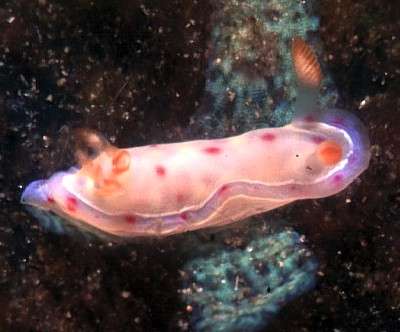
Dear Bill,
You will find attached, a photo of what is believed to be a juvenile specimen of Hexabranchus sanguineus taken at Dauin, Negros Oriental, Philippines on a recent trip.
What do you think?
Cheers;
Michael D. Miller
mdmiller@cts.com
Miller, M.D., 1999 (Jul 6) Juvenile Hexabranchus from Philippines. [Message in] Sea Slug Forum. Australian Museum, Sydney. Available from http://www.seaslugforum.net/find/1013Dear Mike,
Yes its a juvenile Hexabranchus sanguineus. It's a bit hard to see from the photo but each gill is separately attached to the mantle, just as in the adults, and of course its radula is quite different.
It has a remarkable resemblance to some purple spotted chromodorids such as Hypselodoris maculosa, Thorunna australis and Chromodoris decora.
Reference: Rudman, W.B. (1986) The Chromodorididae (Opisthobranchia: Mollusca) of the Indo-West Pacific: Noumea purpurea and Chromodoris decora colour groups. Zoological Journal of the Linnean Society 86(4): 309-353.
Bill Rudman.
Rudman, W.B., 1999 (Jul 6). Comment on Juvenile Hexabranchus from Philippines by Michael D. Miller. [Message in] Sea Slug Forum. Australian Museum, Sydney. Available from http://www.seaslugforum.net/find/1013Re: Tatiana's query on 'Spanish Dancer'
June 16, 1999
From: Bill Rudman
Rudman, W.B., 1999 (Jun 16) Re: Tatiana's query on 'Spanish Dancer'.
[Message in] Sea Slug Forum. Australian Museum, Sydney.
Available from http://www.seaslugforum.net/find/943
Dear Tatiana,
In answer to your question, have a look on the Hexabranchus sanguineus Page, both above and below your message, and you will find information on the Spanish Dancer and how it got its name. If you have further questions, let me know.
Good Luck with your project,
Bill Rudman.
The 'Spanish dancer'
June 12, 1999
From: Tatiana
Hi.
Well ya know how the Spanish dancer is a nudibranch?. Well I'd like to know what a nudibranch is and if you have some info on the Spanish dancer like on where it lives and stuff I'd really appreciate it if you would send it to me. And one more thing What is a Hexabranchus sanguineus?
And also if you could get the info and answers please send it to me as soon as possible because I need this info for a science fair in school.
Thanx please reply quickly!
tbug1988@webtv.com
Awaiting a reply from Bill.
Peter Firminger
Web Manager
'Dancing' Hexabranchus sanguineus
April 26, 1999
From: Wayne Ellis
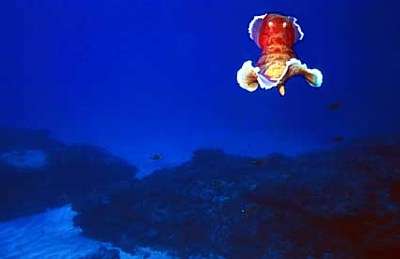
Hi Bill ,
Here is a picture of Hexabranchus 'dancing' for the Forum. It was taken during the October 1987, Lord Howe Island Fauna. [Lord Howe Island is a small island off the east coast of New South Wales].
Wayne
glaskin@ozemail.com.au
Ellis, W., 1999 (Apr 26) 'Dancing' Hexabranchus sanguineus. [Message in] Sea Slug Forum. Australian Museum, Sydney. Available from http://www.seaslugforum.net/find/803Thanks Wayne,
What a spectacular photo. They are really amazing swimmers. I don't know how they can keep going for so long. I have seem them flapping their mantle 'wings' non-stop for over an hour! - and if they don't keep flapping they sink.
Bill Rudman.
Re: Hexabranchus - thanks again
April 17, 1999
From: Caleb & Jamie
Thank you very much for the information about the sea slug. We were not able to find food for it so we decided to release it where we found it. It was a very beautiful addition to our aquarium for a week.
Thanks again,
Caleb & Jamie
Nakacom@aol.com
Re: Hawaiian Hexabranchus
April 6, 1999
From: Caleb & Jamie
Thanks for all the information and support
mahalo
Caleb & Jamie
Nakacom@aol.com
Hexabranchus photos
March 31, 1999
From: Erwin Koehler

Dear Bill,
Concerning your request for Hexabranchus photos. Here is a red-orange one (upper) from the Philippines and a red one from the Red Sea (lower).
Erwin
E.Koehler@deutschepost.de
Koehler, E., 1999 (Mar 31) Hexabranchus photos. [Message in] Sea Slug Forum. Australian Museum, Sydney. Available from http://www.seaslugforum.net/find/747Thanks very much Erwin.
Bill Rudman.
Sea Slug from Hawaii
March 29, 1999
From: Caleb and Jamie
I found a beautiful red and orange sea slug very similar to mimasa (?), but it will sometimes spread out wings? and swim through the water with a flying motion. It has large tentacles on its head as well as some anemone looking things on its back near the end of it. I was wondering if I should give it to the Waikiki Aquarium, or if you could provide some information on its food as well as its scientific name. Sorry not to much information and no picture.
Mahalo nui Loa (Thanks in Hawaiian)
Caleb and Jamie
Nakacom@aol.com
Dear Caleb & Jamie,
I am pretty sure you are describing Hexabranchus sanguineus, and perhaps the yellow colour form I have illustrated above. Usually this species has a brilliant red and white colour pattern and hopefully someone kind will send us a photo to put on the Forum. Hexabranchus is often called the Spanish Dancer because the frilly edge to its mantle looks like the dress of a Spanish Flamenco Dancer.
The "wings" your describe are really part of its back or 'mantle'. In the more common red colour form, the upper side of the mantle is brilliantly coloured in red and white, while the underside is a dull mottled colour of pinks, browns and whites. When Hexabranchus is quietly crawling along, its 'wings' are folded over the rest of its back, covering the brilliant colour pattern with the dull mottled underside. When it is disturbed, however, - poked, prodded, nipped etc, it will quickly unfold the mantle to display its bright colour pattern. It then starts to vigorously flap its 'wings' and swim away. Its swimming is basically an escape mechanism and the sudden display of the bright colour pattern is thought to have evolved to startle potential predators such as fish. See the pages on the Forum describing the use of colour in defence and especially 'deimatic colour display'
The tentacles at the front are rhinophores, which it uses to 'smell' its food, and the anemone-looking things on its back are its gills which it uses for breathing.
Hexabranchus, feeds on a variety of sponges.
Best wishes,
Bill Rudman.
